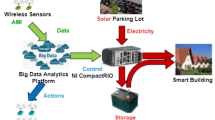Abstract
This paper develops a short-term forecasting system for hourly electricity load demand based on Unobserved Components set up in a State Space framework. The system consists of two options, a univariate model and a non-linear bivariate model that relates demand to temperature. In order to handle the rapidly sampling interval of the data, a multi-rate approach is implemented with models estimated at different frequencies, some of them with ‘periodically amplitude modulated’ properties. The non-linear relation between demand and temperature is identified via a Data-Based Mechanistic approach and finally implemented by Radial Basis Functions. The models also include signal extraction of daily and weekly components. Both models are tested on the basis of a thorough experiment in which other options, like ARIMA and Artificial Neural Networks are also used. The models proposed compare very favourably with the rest of alternatives in forecasting load demand.



Similar content being viewed by others
References
Abu-El Magd MA and Sinha NK (1982). Short-term demand modelling and forecasting: A review. IEEE Trans Syst Man Cybernet SMC-12: 3–10.
Baczynski D and Parol M (2004). Influence of artificial neural network structure on quality of short-term electric energy consumption forecast. IEE Procee—Gen Trans Dist 151: 241–245.
Beccali M, Cellura M, Lo Brano V and Marvuglia A (2004). Forecasting daily urban electric load profiles using artificial neural networks. Ener Conv Mngt 45: 2879–2900.
Buhmann MD (2003). Radial Basis Functions: Theory and Implementations. Cambridge University Press: Cambridge.
Bunn DW and Farmer ED (1985). Comparative Models for Electrical Load Forecasting. John Wiley: New York.
Contreras J, Espínola R, Nogales FJ and Conejo A (2003). ARIMA models to predict next-day electricity prices. IEEE Trans Power Syst 18: 1014–1020.
Engle RF, Granger CWJ, Rice J and Weiss A (1986). Semiparametric estimates of the relation between weather and electricity sales. J Am Stat Assoc 81: 310–321.
Hagan MT, Demuth HB and Beale MH (1996). Neural Network design. PWS Publishing: Boston, MA.
Harvey AC (1989). Forecasting Structural Time Series Models and the Kalman Filter. Cambridge University Press: Cambridge.
Harvey AC and Koopman SJ (1993). Forecasting hourly electricity demand using time-varying splines. J Am Stat Assoc 88: 1228–1242.
Hastie TJ and Tibshirani RJ (1996). Generalised Additive models. Chapman and Hall: London.
Hippert HS and Pedreira CE (2004). Estimating temperature profiles for short-term load forecasting: Neural networks compared to linear models. IEE Procee—Gen Trans Dist 151: 543–547.
Jarque CM and Bera AK (1980). Efficient tests for normality, homoskedasticity and serial independence of regression residuals. Econom Lett 6: 255–259.
Kumluca A and Erkmen I (2003). A hybrid learning for neural networks applied to short term load forecasting. Neurocomputing 51: 495–500.
Ljung GM and Box GEP (1978). On a measure of lack of fit in time series models. Biometrika 66: 67–72.
Niebur D (1995). Artificial neural networks in the power industry, survey and applications. Neur Net World 6: 945–950.
Nogales FJ and Conejo AJ (2006). Electricity price forecasting through transfer function models. J Opl Res Soc 57: 350–356.
Pedregal DJ and Young PC (2002). Statistical approaches to modelling and forecasting time series. In: Clements M. and Hendry D. (eds). Companion to Economic Forecasting. Blackwell Publishers: Oxford, pp. 69–104.
Pedregal DJ and Young PC (2006). Modulated cycles, an approach to modelling periodic components from rapidly sampled data. Int J Forecast 22: 181–194.
Senjyu T, Mandal P, Uezato K and Funabashi T (2005). Next day load curve forecasting using hybrid correction method. IEEE Trans Power Syst 20: 102–109.
Taylor CJ, Pedregal DJ, Young PC and Tych W (2007). Environmental time series analysis and forecasting with the Captain toolbox. Environ Model Software, 22: 797–814.
Taylor JW (2003). Short-term electricity demand forecasting using double seasonal exponential smoothing. J Opl Res Soc 54: 799–804.
Taylor JW and Buizza R (2003). Using weather ensemble predictions in electricity demand forecasting. Int J Forecast 19: 57–70.
Taylor JW and Majithia S (2000). Using combined forecasts with changing weights for electricity demand profiling. J Opl Res Soc 51: 72–82.
Taylor JW, Menezes LM and McSharry PE (2006). A comparison of univariate methods for forecasting electricity demand up to a day ahead. Int J Forecast 22: 1–16.
Tych W, Pedregal DJ, Young PC and Davies J (2002). An unobserved component model for multi-rate forecasting of telephone call demand: the design of a forecasting support system. Int J Forecast 18: 673–695.
Young PC (1999). Data based mechanistic modelling, generalised sensitivity and dominant mode analysis. Comput Phys Commun 115: 1–17.
Young PC and Beven KJ (1994). Data-based mechanistic modelling and the rainfall-flow nonlinearity. Environmetrics 5: 335–363.
Young PC and Pedregal DJ (1997). Data-based mechanistic modelling. In: Heij C. et al (ed). System Dynamics in Economic and Financial Models. John Wiley: Chichester, pp. 169–213.
Young PC, Pedregal DJ and Tych W (1999). Dynamic harmonic regression. J Forecast 18: 369–394.
Acknowledgements
We are most grateful to the UK Engineering and Physical and Science Research Council (EPSRC: Grant ESA7088) and two British Companies that provided the data used in this project. We also would like to thank two anonymous referees and the editor's comments on a previous version of this paper. Readers interested in further technical details may ask the authors for an expanded version of this paper.
Author information
Authors and Affiliations
Corresponding author
Rights and permissions
About this article
Cite this article
Pedregal, D., Young, P. Development of improved adaptive approaches to electricity demand forecasting. J Oper Res Soc 59, 1066–1076 (2008). https://doi.org/10.1057/palgrave.jors.2602447
Received:
Accepted:
Published:
Issue Date:
DOI: https://doi.org/10.1057/palgrave.jors.2602447




